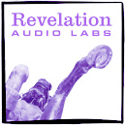|
Revealing the organic truth in music. Hand crafted in the U.S.A. Fine artisan-built analog, digital, loudspeaker, power, and video cables featuring ultra-pure Cryo-Silver™ deep cryogenic treated 99.999% solid silver conductors, Big Air™ dielectrics, and Ceramic Micro-Sphere Conduit™.
|
You are reading the older HTML site
Positive Feedback
ISSUE
23
january/february
cary audio
CD-306 SACD player
as reviewed by Dave Clark
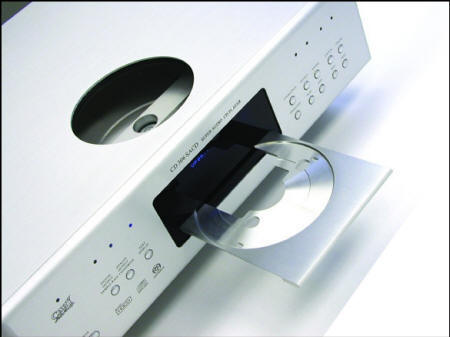
|
DAVE AND CAROL CLARK'S SYSTEM:
LOUDSPEAKERS
ELECTRONICS
SOURCES
CABLES
ACCESSORIES |
We have been delighted owners of the Cary 306/200 CD player for a few years now (see my review here) and it has served us exceedingly well by being our player of choice. When it first came out a few years ago, it was truly a SOTA machine at its then asking price of $5k. True we have not heard them all, but we have had in house the Accuphase DP-55, a Gryphon Mikado, a stock Sony XA-777ES, and the Metronome CD1-V. Add to those various DACs and transports, visiting friends with their players of choice, shows, and the recurring CES bizarrio dream, and I have a decent idea of what is out there that I could reasonably afford (which left out the $6k and up digital sources!). That is, while we have heard a lot of very nice players, none of them made us scream, We'll take it!" Well, except the Sony, which was ours if and when we found an SACD title that we liked—still looking …and waiting …and looking ...sigh.
Ah, yes the Sony XA777ES. With Redbook, the Sony was too dark and ho-hum …no excitement, no magic, and no fun! The Sony sounded like baloney—bland. True, there was the occasional CD that on the Sony sounded better than on the Cary, but only because the Sony was such a non-resolving laid-back machine. On the other hand, with good Redbook CD (and there is quite a lot good Redbook material out there), the Cary was simply the choice for us based on its synergy with our system and our musical and sonical preferences—that is its strengths and weaknesses felt just right whenever we spun some silver. Okay, is the Cary perfect? Of course not. For some it was too upfront, too revealing, too visceral, too neutral, too much of a smacking good thing—the Cary 306/200 will hit you upside your melon in a way that gets the music right into yer groove thang!
So why now the Cary 306 SACD player? Huh, good question. Certainly not because of the ton of SACD titles we just have to have! This is not meant to be a slam against SACD/DSD. It is, without a doubt, better than Redbook. The problem is that the music Carol and I listen to is simply NOT on SACD, nor may it ever. Therefore, the best in Redbook is what we are after …like what had we found through the Cary 306/200 (though when the stuff we like does come out on SACD, it would be nice to have a killer machine for that format well! And Carol says ...we got Godsmack and NIN!).
Audio nervosa? Na, been there, done that. Wait a gosh darn ganoodle there Dave …you said you wanted the best in Redbook CD? Yeah ...rriiiiight! I guess that is what turned us onto the new Cary 306 SACD player. See, it was close to a year and a half year ago that Dennis Had mentioned the soon to be released 306 SACD player. It was not going to be just a re-tooled 306/200 with SACD tossed into the mix, but a completely new machine that would make Redbook on the older 306/200 sound, well …like Redbook on an older machine. It was Dennis's intent that the new player should far exceed the musicality and sonic performance of the older 306/200 on Redbook, thereby setting a new benchmark for what $6k can get ya! Plus, you get SACD! Meaning that since we really, really, really liked the older 306/200, we should then go gagga over the newer one! REALLY!
Of course, there are other "benchmark" players we could have pursued, but the issue for us was that we wanted the best we could afford on two teachers' salaries—meaning that we are to a great degree, real world audiophiles. Yeah right, whatever that may mean! We also wanted the best from a company that should be around for a long time—like Cary. Moreover, we wanted something that has the perception of reliability and being hassle free—not something tweaked to the edge of sanity or coming from the far end of the audio fringe. Neither of which is a bad thing, it is just not where we wanted to go with a CD player that would set us back some serious cash. (While I have heard and read very good things about modded players from Dan Wright, Allen Wright, and others, I have not heard them here and therefore can make no real judgment on how they would stack up to the Cary 306 SACD—perhaps a future endeavor!)
Now Dennis… what happened my man? We should have seen the 306 SACD player like a year ago!
Uh well, Dennis found that the more they worked on the player, the more they could make it better, not just better, but way mo betta… How so? Like re-doing the 306 SACD's analog output stage all over again, which then required changing this, which then required changing that, and …meaning that it took just wee bit longer than expected.
Ah, but good things come to those that wait, and well …the Cary 306 SACD player is a very good thing. After many a postponement, ours finally came in the fall of 2005, where upon the heavens parted (well actually it was the truck's doors that opened with the box intact) and 306's laser light showered us in all its Redbook glory (meaning it worked and played a disc). Hey, at least I didn't say, "Upon opening the box and listening to the first 2 seconds of our favorite CD, my jaw dropped as it revealed to us a completely different and new musical experience from something" ...or something even more clichéd! Now, admit it, you would have liked that, wouldn't you…? Ah, then I will save that for later!
Let me digress here a bit and offer you a few descriptions of the player in terms of design, ergonomics, and whatnot.
To quote from Cary, the CD-306 SACD player:
...includes an all aluminum chassis with custom-machined aluminum cone feet, eight (8) Burr Brown 1792u DAC chips running in parallel pairs, it has the ability to play multi channel SACD disks as stereo down mix or to play stereo playback of SACD disks. It incorporates the finest available SACD drive, the SCD 1 digital drive. It has a top panel drive mechanism viewing window with an integral bubble level balance. The interior houses four power transformers to make the power supplies separate for all critical circuits. On the back panel it has XLR, RCA and TOSLINK digital inputs to work as a digital processor for an external digital signal like an iPod or a digital cable box. It also has XLR, RCA and TOSLINK digital outputs. In addition, it has balanced XLR and RCA single ended analog outputs. CD disks played in the CD 306 SACD can be played back at 44.1 kHz to utilize the Pacific Microsonics PMD 200 digital filter to decode HDCD encoded CD disks. CD 306 SACD can also upsample a CD disk from 44.1 kHz to 96, 192, 384, 512 or 768 kHz to release all the information available in your CD disk library. It will take an external digital signal and play it back at 44.1 kHz or let you choose digital upsampling rates of 96 or 192 kHz.
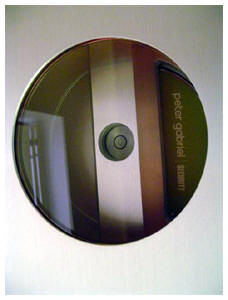 Compared
to the new 306 SACD player, the older 306/200 had only two C-core power
transformers (one for digital and one for analog) though it did have eight Burr
Brown 1704u DAC chips (four per channel with an inherent upsampling limit of 196
kHz). Like the new 306 SACD, it could also handle an HDCD disc by its Pacific
Microsonics PMD-200 chip, and be used as a DAC via its plethora of digital
inputs. Based on what I have read and heard, the two players seem to share the
same "divided into thirds" layout—left third power supplies, center third
shielded transport, and right third digital/analog boards—though I have yet
confirm this officially by opening the newer player. Visually, the two are very
similar, but as mentioned above, the new 306 has the oh-so-cool window on its
top lid for the audio voyeur in all of us—you can watch the disc spinning and
verify the player's level-ness via the bubble level sitting directly
above the spindle of the Sony SCD-1 drive.
Compared
to the new 306 SACD player, the older 306/200 had only two C-core power
transformers (one for digital and one for analog) though it did have eight Burr
Brown 1704u DAC chips (four per channel with an inherent upsampling limit of 196
kHz). Like the new 306 SACD, it could also handle an HDCD disc by its Pacific
Microsonics PMD-200 chip, and be used as a DAC via its plethora of digital
inputs. Based on what I have read and heard, the two players seem to share the
same "divided into thirds" layout—left third power supplies, center third
shielded transport, and right third digital/analog boards—though I have yet
confirm this officially by opening the newer player. Visually, the two are very
similar, but as mentioned above, the new 306 has the oh-so-cool window on its
top lid for the audio voyeur in all of us—you can watch the disc spinning and
verify the player's level-ness via the bubble level sitting directly
above the spindle of the Sony SCD-1 drive.
While the Sony SCD-1 was a top loader, the Cary 306 SACD is a front loader via the slim (ah to be that slim again…) machined aluminum drawer. The Sony SCD-1 drive has the reputation of being one of the better drives around, but it is so slow in reading a disc that… (and the crowd shouts out) "How slow is it?" It is so slow… that; well… the Cary ain't slow! It reads a disc in less than 5 seconds, which begs the question, "How did Cary do it?" Better software, better implementation of the drive… uh, yeah, like better Cary engineering. It is quick on its feet and quiet as a clam! Very smooth and almost glitch free. [Cary bought an SACD license from Sony (allowing them the use of the SACD logo and access to all of Sony’s SACD resources). Along with this, they bought 500 SCD-1 (with the ability to buy another 500) drives/transports (this includes the reader board, motor drive, and laser head—the whole SCD-1 transport/drive assembly as one complete unit). Cary then disassembles the SCD-1 drive/transport unit and converts it from a fixed head drive to a moving head drive so that it can be used in the front-loading 306—but, it is still the SCD-1 laser head, motor assembly (CD drive motor/spindle), and reader board. Cary then writes their own software to load and read discs. The sled assembly is all Cary. I guess in the end, it is really more of a Cary drive, though based on all Sony SCD-1 parts.]
What do you mean almost glitch free? Whatchoo you talkin' ‘about Willis?! Okay, on a few occasions it had a hiccup or two. Nothing serious, but if we have to whine about it like a one of my students, then… like twice, the drawer stuck, when I was trying to open it, (had the unit only a week), and like perhaps, three times, with the remote, I was going from track 3, to track 4, and then back to track 1, and then forward to track 7, and then back to track 5, and it didn't want to work! So I say, to the 306 SACD, "Geesh, what's yer problem?! I mean, now I have to get up, walk over to the you, hit stop, open the drawer, and start it from the beginning… what a piece of crap!"
Okay, let's see here. I gave it a series of commands via the remote from across the room in like five seconds, and it froze! Figure it out man! It ain't the machine, it's me! I am a victim of my own kludgedness—nothing else—meaning that the player has been pretty much hassle free since day one. After all, we are adults and things happen—no need to act like a child crying over spilled milk. No wait, I forgot something…regressing back into a ten year old… like twice, when I just had it, and I was running it on repeat for like a gazillion hours, it stopped by itself, and I had to hit play again… okay that's enough! Things happen time, to move and deal with it! Geesh, get a life will ya!
Seriously, though, there are two real issues I had to deal with that may or may not be of any importance to you, but consider this a heads up. First off, the new 306 allows one to level the player by rotating one of the four metal cone feet, though in my set-up they imparted a significant detriment to the sound. This did not take me by surprise as I had experienced this phenomenon before—metal on metal resulting in a metallic quality to the music. That is a Townshend Audio 3D Seismic Sink sits under the Cary 306 SACD offering a great degree of isolation from the room, as well as minimizing the player's own vibrations. However, the downside is that the Townshend has a metal surface, the Cary's cone/feet are metal, and two metals make for bad sonics. Solution? How about some wood? Not that kind of wood, but wood cups under each cone to counteract the metal-to-metal interactions. You know, a little wood seasoning based on the sonic characteristics of a given wood-type. Tried some mahogany—too mid-rangy. Tried some teak—too colored in the upper bass. Tried some maple—too dull overall, and hey, where'd the details go?. Huh… what to do? Ah, how about some hard rubber washers under the tips of the cones? Nothing too big or too thick—something just big enough to keep the cones off the surface of the Townshend. At the local "I-think-I-can-do-it-store," I find some faucet washers that look like they should do the trick. Yikes,… sounds like music he says… no metallic presence, no loss of resolution, no colorations… just the Cary 306… sounds way good!
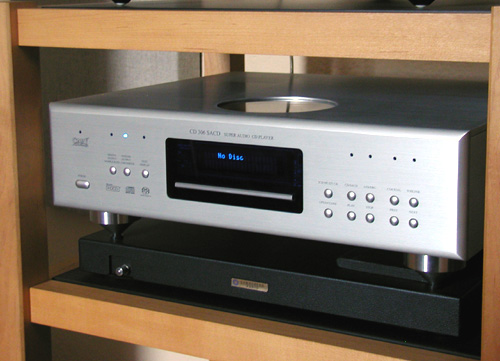
Second, while Cary (the company) and others on the web feel that the player needs anywhere from 100-300 hours of playing time to be ready for prime time. I tried that and at 300 hours, it was a no-go—still not happening musically. A good 500-600 hours seemed to be a point where the player lost any sense of "stiffness" or that proverbial "sounds really good now, but wait till it is broken-in" sort of thing. That is, out of the box, the 306 is quite impressive, but had the characteristic of being hard or stiff, and closed in—it really needed to open-up musically. The music simply did not flow or have the naturalness that the older 306/200 possessed—especially when listened to at the up-sampled 196kHz settings. The older 306/200 was simply better. That player had well over 1500 hours on it, and like a pair of old and worn shoes, it sounded very comfortable to my ears, and like a new pair shoes, the new 306 SACD simply needs time to loosen up. Lots of time, so be patient.
Which all leads to a conundrum or sorts: how best to break-in the new player? Do you have to break-in with SACD and/or Redbook? Are they interchangeable? After all, they do use the same DAC chips, though DSD is 768kHz versus 44.1kHz for Redbook. But what about the individual upsampling frequencies, do they each require a set number of hours to be settled in? Do I need to run Redbook at 44.1, 96, 192, 384, 512, and 768kHz for like 300 hours each?! And what about HDCD?! The mind boggles. But, it occurred to me that since both formats share the same DAC chips and analog output stage (and perhaps power supplies too), why not spin an SACD disc for set period of time (breaking in that part of the laser and what-not while running the 1792u chips at 768kHz).
Next I could spin some Redbook discs for a while (different laser and what-not, though now up-sampled to 768 kHz—idea being that the lower sampling rates are still being addressed by DAC's computational exercises at 768kHz). For the fun of it, I could also down-sample at the different settings (44.1, 96, 192, 384, and 512kHz), thereby addressing any doubts that kept me awake at night worrying that the player will never sound right if I did not get everything ran in that I should of ran in because somehow it would all make a difference!
And for the final touch, feed the player via its digital-in (say from our Polk XM receiver) a 44.1kHz signal, and have that up-sampled at the different settings (96, 192, 384, 512, and 768kHz), and fed out to the analog output stage as well. This by the way, allows XM radio to sound pretty good for a highly compressed signal!
Seems I had pretty much covered all the bases here—and did so for 500-600 hours—though I did have a couple of questions for Cary as I did the digital input break-in dance:
1) Will a digital signal fed into the player see the same "pathway" (minus the obvious section from the transport) as a signal coming from the transport, thereby breaking-in the DACs and analog output stage. Seems that the answer should be yes, or am I off the deep end here?
2) You say that any 44.1kHz digital input can only be up-sampled to 196 kHz, but the player allows via the remote (as shown on the display) that one can select up to 768kHz. Am I misreading something here?
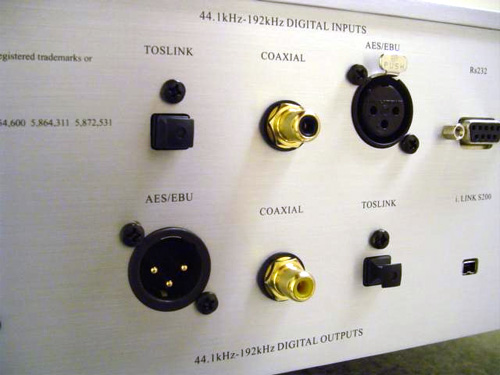
So how does it sound now?
Like butter on a spring day in the south of France. Warm, rich, smooth, colorful, ooohh so flavorful, but not all that good for you—all I want to do is sit and spin discs, and I need exercise! The 306 SACD is simply bad for your health. Once you buy one, you will get no exercise—unless you count getting up and changing disc after disc, tapping your foot to the rhythm, and bobbing your head and swaying to the music. All you'll want to do is sit and listen to your CD/SACD collection, because the 306 SACD will simply reveal more information that is musical, more detail, more presence and palpable realism of what is on the discs making each one a new musical experience.
Yes another cliché, but what else can I say? The Cary 306 SACD, with any disc we have tossed its way, has revealed more instrumental texture and realnessness than previously heard from any other digital source here in my home. Instruments and vocalists take on a greater sense of thereness with a dimensionality and spatial-awareness that allows one to get that much closer to the recording event. Images are presented with much more air and presence—make that individuality - yet they do not stand alone in the sense that they are separate from the rest of the musical tapestry. No, they all play together as a musical cloth—the Cary just allows each thread to stand out with a greater sense of delineation and purpose. That is, you have a greater sense of each instrument's texture allowing you to feel or sense the notes or music as never before—tonally, harmonically, spatially the music sounds so captivatingly right.
All without a hint of stridency, glare, grit, or other digital nasties, of which, are easily misinterpreted as detail and resolution. Harmonically and tonally, the Cary is quite balanced coming across as being very neutral without any sense of that nomenclature's stigma of being thin, lean, analytical, bleached, etc. The Cary simply gets the music across to you in a well-balanced, grab you by the throat, viscerally captivating way. Nothing stands out as being either too much or not enough. Nevertheless, is it perfect? Will everyone want to have one on his or her rack? Uh… no.
For some listeners, they may find its personality to be a bit too upfront and over the top. To some degree yes, but not to the degree one would assume—let's just say that it is a tad more so than not so. Meaning that the Cary is not shy in how it presents the music. You want laidback and polite? Sorry, but when called upon, you are going to get big and robust with drive and slam, while still being light and quick on its feet… err, cones. Want a perspective of your music that is either "back of the hall" or "front row"? Try more towards the back of the front fourth or so. This is pretty much where I like to be at a concert—not too close and yet just close enough.
The Cary 306 SACD is simply not a forgivable player. That is if a CD is bright and lean, it will be bright and lean and perhaps a tad brighter and leaner than you would like—it gives you what is there in the pits and therefore, many of your CDs will not be musically perfect. It is not going to mask any issues with the format. Bad Redbook, good Redbook, very good Redbook, and excellent Redbook, will sound just like that; bad, good, very good, and excellent. This is not a euphonic CD player or one that will cover the sins of Redbook. For that, you will need to look elsewhere.
On the other hand, if you want the bad-ass-t bass on your street the Cary will push the limits of your speakers and room with the deepest, tightest, and most tactile bass ever experienced—while still being well balanced and not over the top in that respect. That is the bass will not draw attention to itself, unless that was the intent in the recording. No boom, sludge, or artificial fullness. You will simply hear the bass in all its glory—assuming that you have the room and speakers to do so. I thought the older 306/200 was the leader in the bottom end, but it has nothing on the new 306 SACD. We are (yes here we go again) hearing the bass frequencies with a completely new awareness and appreciation. Laswell, Wobble, Yello, and the list goes on, will startle you in what lies below on their discs. We are hearing rattles in the room that before were un-rattled! The 306 SACD player has more control, dynamics, and power than the older 306/200—is this due to more power supplies we ask …or the new analog output stage? As someone who loves a good tight bottom end—who cares?! The 306 SACD is as good as it gets!
But what about the upsampling? Is it worth it? Well that is more a matter of taste or preference. I have read about people who find anything other than the 44.1kHz default to be non-musical, and yet here the 512kHz seems to the best of the lot. What I hear at 512kHz is a greater sense of natural warmth or ease—it simply sounds more like music to us. Tinned ear cronies! I sorry, what was that? The 768kHz offers more perceived resolution or detail, but for us it tends to be too much of a good thing. The other settings tend to thin things out a bit when compared to the 512kHz setting. However, like I said, this is more of a personal preference and reaction to what the upsampling is doing to the signal—and that is…? By pushing the cutoff further up the frequency ladder, it is adding potentially more noise (I assume) to the music. You get more noise of a higher nature added onto the signal—either you'll like what it does to the rest of the music, or you won't. The cool thing is that it is all selectable from the remote without the need to stop the CD—hit any up-sampling button and voila, there you go!
Of course, all that I am writing here is to a great degree system and personal preference. I like what the Cary does here, and my system is a perfect synergy for its sonic personality. Even so, this is not digital as we have come expect, but nor is it analog—analog is analog. But this is darn close and just goes to show how far digital has come in the past 30 or so years. Kudos to Dennis and his team in pushing Redbook to its limits in 2005!
I will admit that my time with the player on SACD has been quite limited as I own only a couple of titles. Even so, they sounded very nice indeed coming oh-so close to their analog brethren. Analog still wins the title, but the Cary 306 SACD at $6k is a joy to listen to, though I can visualize those who would not find it to be their cup of tea. As I said earlier, anyone who wants all of his or her discs to sound simply magical, had best look elsewhere. The Cary is all about truth in the music. If it is there on the disc, you will hear it and more, if not, then you better keep looking for something else.
The highest recommendation I can offer is that I sent a check for mine. Give it a listen. Dave Clark
CD-306 SACD Specifications
-
Weight: 50 lb.
-
Dimensions: 5" H x 18" W x 15" D
-
Transport: SCD-1
-
Master Clock Jitter: Below measurable levels, with a digital buffer circuit to eliminate jitter.
-
Digital Sample Rates (Fs): 44.1, 96, 192, 384, 512 or 768kHz sample rates for CD playback to the analog audio outputs, 44.1, 96 or 192kHz Fs for digital inputs
-
Digital/Analog Converters: 8 Burr Brown PCM-1792u, four per channel
-
Analog Filter: 3rd Order Bessel
-
Analog Outputs: Balanced XLR, Single-Ended RCA
-
Digital Outputs: AES/EBU, Coaxial, Toslink (1 each)
-
Digital Input: AES/EBU, Coaxial, Toslink (1 each)
-
Digital Input Sample Rate: 32kHz, 44.1kHz, 48kHz, 88.2kHz, 96kHz or 192kHz, Accepts 16, 20, or 24 bits
-
Frequency Range: 2Hz - 80kHz (@ 192kHz)
-
Amplitude Linearity: 0.1dB (20Hz - 20kHz)
-
Phase Linearity: 3 degrees (20Hz - 20kHz)
-
Dynamic Range: 130dB (1 kHz)
-
Signal-to-Noise Ratio: 133 (1kHz)
-
Channel Separation: 110 (1kHz)
-
Total Harmonic Distortion: 0.0008% (1kHz) THD
-
Audio Output Level: Single-Ended 3.0 Vrms, Balanced XLR 6.0 Vrms
-
Power Input: Configured at the factory for 100-120 or 200-240 Volts AC @ 50-60Hz
-
Special Features: SACD playback stays in pure DSD format all the way to the analog outputs. It is not converted to PCM in the CD 306 SACD player. ALL aluminum chassis, with either silver or black anodized finish, top panel view window for the drive mechanism and the inset bubble level balance, adjustable metal cone feet, dual C-core transformer power supplies, fully regulated power supply circuits, SACD stereo down mix from multi-channel SACD disks. HDCD decoding at 44.1 kHz Fs, SACD, CD, HDCD playback. Rear panel RS-232 port control for remote operation in custom installations, remote handset included.
-
Power Consumption: Rated 35 watts during playback and 7 watts during standby operation.
CD-306 SACD/CD player
Retail $6000
Cary Audio
TEL: 919. 481. 4494
web address: www.caryaudio.com
e-mail: [email protected]
